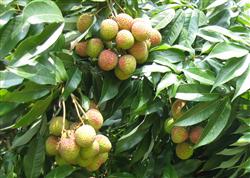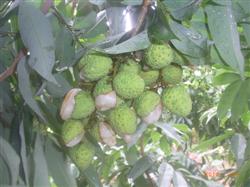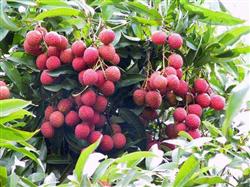What pesticides are commonly used in Feizixiao litchi?

What pesticides are commonly used in Feizixiao litchi? Which pesticides can be hit by which insect pests? Feizixiao litchi commonly used pesticides are: insecticide spray insecticide trichlorfon broad-spectrum, high-efficiency and low-toxicity organophosphorus pesticides. With strong stomach toxicity and contact effect, it is the most widely used, most effective and cheapest agent to control litchi bug at present. In addition, it has a good control effect on a variety of Lepidoptera larvae and beetle adults that eat fruit, leaves and tender shoots. The commonly used concentration is 90% trichlorfon 600 × 800 times solution. But the effect on aphids and mites is poor. Dimethoate broad-spectrum, moderately toxic organophosphorus insecticides and acaricides. It has obvious internal absorption and can be absorbed by all parts of the plant, so it is especially suitable for controlling pests such as thrips, aphids, litchi gall mites and so on. The usual concentration is 40% EC 1000 times. Omethoate broad-spectrum, endospermic insecticidal, worm killer. It can control a variety of insect pests with piercing and sucking mouthparts, especially aphids, mites and scales that have developed resistance to dimethoate, and has a special effect on litchi gall midge eggs and newly hatched larvae. The common concentration is 40% EC 1000-2000 times. Because of its strong internal absorption, it can be used not only for rapid spraying, but also for root application, smearing, bandaging and other ways of application. Omethoate is a highly toxic pesticide and has a long residue period. Safety must be paid attention to when using omethoate. It is prohibited to be used within one month before harvest. It is suggested that it should be used to clear the garden in winter and spring. The broad-spectrum insecticidal and acaricidal agents of imidophos have contact toxicity, stomach toxicity and certain internal absorption, with moderate toxicity. 800 000 times of 25% EC is often used to control aphids, thrips, gall mites, larvae of Lepidoptera, etc. Quick culling (also known as methamidophos) has a strong contact and stomach toxicity. It has strong penetration ability, can penetrate into the waxy layer on the surface of insects, and has a special effect on scale. The commonly used concentration is 40% EC 600 to 800 times. It is a highly toxic pesticide and must be used safely. It is forbidden to use quinathion broad-spectrum insecticidal and acaricidal agents within months before fruit harvest. It has contact and stomach toxicity, but has no internal sighing effect. It has good permeability, so it can kill eggs to a certain extent. It is often used to control litchi stem borer, gall mite and scale. The common concentration is 25% EC 800-1000 times. Quinathion is highly toxic to bees and fish and the colony must be removed before application. Wanling (also known as methomyl) is a carbamate insecticide with wide insecticidal spectrum and rapid efficacy. It decomposes quickly on crops, so its residual period is short, and its egg killing ability to some pests is more prominent. at present, it is widely used in the control of thrips in melons, fruits, lai, tobacco and other crops. The control of litchi thrips can be sprayed with 24% water-soluble liquid 600-800 times. However, Wanling is a highly toxic pesticide, so special attention should be paid to safety when using it. Shachongshuang is a new variety of organic nitrogen pesticides developed in China in the 1970s, and its action mechanism, scope of application and method of use are basically the same as those of Batan. But because it is a domestic pesticide, the price is cheap and very popular. In litchi production, 500-fold solution of 25% water agent is commonly used to control many kinds of pests, such as stem borer, fine moth, leaf roll moth, red head borer, thrips, aphids, gall mites, gall mosquitoes and so on. Badan is a derivative of Bombyx mori toxin, which has strong stomach toxicity, contact killing effect, antifeedant and egg killing effect. It has a wide insecticidal spectrum and can be widely used to control Lepidoptera, Coleoptera, Hemiptera, Diptera and other pests in food crops, fruits, lai and other crops. Because the insecticidal mechanism of Batan is to block the transmission of insect nervous system, which is completely different from the action mechanism of organochlorine, organophosphorus and carbamate insecticides, so it is especially suitable for the control of pests resistant to these kinds of pesticides. Batan has a good internal absorption effect, in addition to spray, it can also be used as root zone pesticide. Although Batan is moderately toxic, it is highly toxic to silkworms and fish, so it is generally not suitable to be used in sericulture and fish culture areas. Litchi producing areas commonly used 50% wettable powder 500-800 times liquid to control leaf roll moth, red head borer, thrips and so on. Fenvalerate is a pyrethroid insecticide with broad spectrum, high efficiency, poisoning, strong contact effect on pests and strong knockdown force. it has a good control effect on Lepidoptera larvae and Homoptera, Hemiptera, Orthoptera and Diptera pests, but not on mites and scale insects. Can be used to control litchi small gray butterfly, ulnar moth, diamondback moth and other larvae, commonly used concentration of 20% EC 50008000 times solution. Because fenvalerate has been used for a long time, many species of insects have developed resistance to fenvalerate and have great lethality to parasitic wasps and other natural enemies, so we must pay attention to the choice in practical use. Deltamethrin and pyrethroid insecticides not only have strong contact and stomach toxicity, but also have certain repellent and antifeedant effects. The other properties are similar to fenvalerate. The mixture of deltamethrin and dichlorvos has a special effect on the control of beetle adults. The commonly used concentration is 2.5% EC 2500 Mel 5000 times. Cypermethrin (also known as Xingmianbao, an Lubao, Mibaike, Pepsi) pyrethroid insecticides. It is stable to light and heat, so its performance is relatively stable during storage, and its residual period after field application is longer. It has a good control effect on pests resistant to organophosphorus pesticides, and its other characteristics are similar to those of fenvalerate. Cypermethrin has a special effect on litchi stem borer, Spodoptera litchi, leaf roll moth and so on, and the commonly used concentration is 10% EC 1500-300 times. The stone-sulfur mixture is boiled with lime and sulfur and water. the liquid is reddish brown and smells like smelly eggs, and the effective ingredient is calcium polysulfide, which can kill insects, mites and bacteria, and can be used to control scale, mites, powdery mildew, anthrax and so on. Because it has the advantages of cheap raw materials, easy to make, not easy to produce resistance to diseases and insect pests, long effective period and so on, it is often used as a medicine for orchard cleaning in winter and spring. The concentration varies from season to season. It is 1: 2 Baume in winter and spring and 0.2 ~ 0.4 in autumn. It is not suitable to be used during high temperature in summer to avoid possible drug damage to crops. Stone-sulfur mixture is strongly alkaline, so it can not be mixed with other pesticides. Fumigation insecticide dichlorvos broad-spectrum organophosphorus insecticides are moderately toxic to humans and animals and safe to plants. Dichlorvos has strong volatility and strong fumigation effect on pests, so it can be used to control borer pests. The larvae of longicorn beetles, wood beetles, moths and other larvae can be killed by filling the borer with 80% EC 20: 30 times. Dichlorvos also has good contact and stomach toxicity, so it can dilute spray to control a variety of piercing and sucking or chewing mouthparts pests. 1000 times EC is commonly used to control white moth wax cicada, litchi stem borer, leaf roll moth, red head borer, ulna moth and other Lepidoptera larvae. Aluminum phosphide can absorb water in the air and decompose itself, releasing phosphine gas with strong insecticidal effect. Plug 56% aluminum phosphide tablets 0.1 to 0.2 grams in the cavities of longicorn beetles or bark moth larvae, seal the hole, and kill the pests in the cavities after 3 or 5 days. Aluminum phosphide is a highly toxic pesticide, which must be used by special personnel and pay attention to safety protection. Must be placed in a dry, sealed container during storage. Ke Niu Ling Pill is a new preparation specially developed by Beijing Agricultural College to control forest trunk borer in recent years. Its main active ingredient is zinc phosphide. When in use, as long as you try to plug all or most of the pills into the cavities, after the pills are hygroscopic and damp, the zinc phosphide in the pills interacts with auxiliaries, water and carbon dioxide to slowly release highly toxic phosphine gas. kill the pests with the spread of the worms. Through large-scale and multi-site experiments, Ke Niu Ling capsule was used to control litchi bark moth, Acacia wood beetle moth, coffee leopard bark moth and longicorn beetle larvae. As long as the application method is appropriate, more than 95% control effect can be obtained. Although zinc phosphide is a highly toxic pesticide, it is safe and convenient to use because there are medical capsules on the outside. However, do not be exposed to moisture and mistakenly taken, you must pay attention to sealed and dry environment during storage. Soil insecticide phoxim has the advantages of high efficiency, low toxicity, broad-spectrum insecticide, contact toxicity and stomach toxicity. The lasting period of covering in the soil can be up to 1-3 months, which is most suitable for the control of navel grubs, termites, mole cricket and other underground pests. The results showed that it had high control effect on larvae, pupae and adults unearthed from litchi gall midge. The common dosage is 2.5% granule per mu or 500 grams of 50% EC. Because of the strong effect of photolysis, the residual period for spraying on the ground is very short, so it is very suitable for the control of aboveground pests of fruits, vegetables and other crops. 1000 EC is often used to spray 50% EC. It has a good control effect on Lepidoptera larvae that eat leaves and shoots. Carbofuran (also known as carbofuran) is a broad-spectrum insecticidal and nematicidal agent with outstanding internal absorption and contact and stomach toxicity. The effective period in soil is as long as 40-60 days, so it is especially suitable for the treatment of seedbed, burrow soil, seed treatment and crop root zone application. It is effective in controlling many kinds of soil pests and nematodes, such as grub, mole cricket, ground tiger, golden needle worm and so on. The common dosage is 3% granule 2.5-3kg per mu. Yingran Dan is a highly toxic pesticide, so safety protection measures must be strictly implemented in transportation, storage and use. It is strictly prohibited to apply in vegetables, in the fruit stage, to make suspension spray, and to prevent chemicals from infiltrating into wells and fish ponds. Methyl isophosphates is a broad-spectrum soil insecticide commonly used in China, which has strong contact and stomach toxicity, and is effective in controlling underground pests such as grub, mole cricket, golden needle worm and so on. More than planting holes or combined with topdressing ditch application. The common dosage is 5 kg of 3% granule per mu or 250 ml of 20% EC into poisonous soil, and the effect lasts for 30 days. Methyl isosinophos is a highly toxic pesticide, special attention should be paid to safety protection when using it, and water spray is prohibited. Click to get more litchi planting techniques click to get more fruit planting techniques
- Prev

Feizixiao litchi how to prevent fruit cracking?
Feizixiao litchi how to prevent fruit cracking? What methods are effective? To prevent fruit cracking of Feizixiao litchi, we can refer to the following methods: 1. Root-cutting and ring-cutting: in the later stage of fruit development, root-cutting and ring-cutting are used to weaken the root activity, which is very effective in reducing fruit cracking. But the measures must be timely and appropriate, such as excessive.
- Next

How to manage the cultivation of litchi?
How to manage the cultivation of litchi? Please give introduction to planting litchi can refer to the following methods for planting and management: first, seedling planting 1, the choice of fixed seedlings, first of all, the selection of large seedlings, grafted seedlings require strong growth, thick leaves, stem diameter should be at least above 1.5cm, seedling height should be 60 cm.
Related
- Moge, come on! The staff of the peasant association in the producing area of cantaloupe were frightened when the crowd gathered.
- Causes and Solutions of low Fruit setting rate of Apple
- Symptoms and control measures of passion fruit virus disease
- Fruit growing lesson: how do apple orchards keep high yields?
- Can you build orchards in the mountains? What are the pros and cons?
- How to manage the coloring period of Crisson grape?
- This paper introduces the processing technology of two kinds of fig products.
- How much is a month for retired teachers in rural areas by 2020?
- How can strawberry planting increase sugar content? We should pay attention to management in many aspects.
- What are the cultivation techniques on how to improve the yield of golden fruit?

